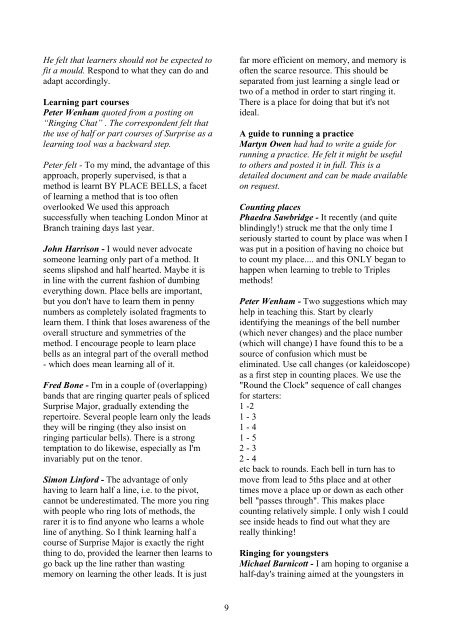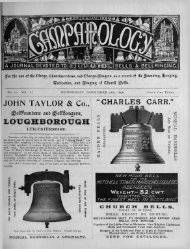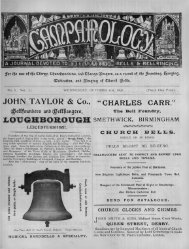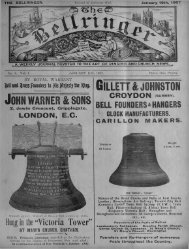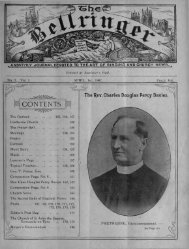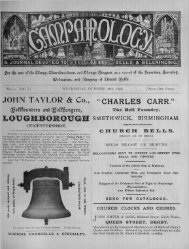The Central Council of Church Bell Ringers Education Committee
The Central Council of Church Bell Ringers Education Committee
The Central Council of Church Bell Ringers Education Committee
You also want an ePaper? Increase the reach of your titles
YUMPU automatically turns print PDFs into web optimized ePapers that Google loves.
He felt that learners should not be expected to<br />
fit a mould. Respond to what they can do and<br />
adapt accordingly.<br />
Learning part courses<br />
Peter Wenham quoted from a posting on<br />
“Ringing Chat” . <strong>The</strong> correspondent felt that<br />
the use <strong>of</strong> half or part courses <strong>of</strong> Surprise as a<br />
learning tool was a backward step.<br />
Peter felt - To my mind, the advantage <strong>of</strong> this<br />
approach, properly supervised, is that a<br />
method is learnt BY PLACE BELLS, a facet<br />
<strong>of</strong> learning a method that is too <strong>of</strong>ten<br />
overlooked We used this approach<br />
successfully when teaching London Minor at<br />
Branch training days last year.<br />
John Harrison - I would never advocate<br />
someone learning only part <strong>of</strong> a method. It<br />
seems slipshod and half hearted. Maybe it is<br />
in line with the current fashion <strong>of</strong> dumbing<br />
everything down. Place bells are important,<br />
but you don't have to learn them in penny<br />
numbers as completely isolated fragments to<br />
learn them. I think that loses awareness <strong>of</strong> the<br />
overall structure and symmetries <strong>of</strong> the<br />
method. I encourage people to learn place<br />
bells as an integral part <strong>of</strong> the overall method<br />
- which does mean learning all <strong>of</strong> it.<br />
Fred Bone - I'm in a couple <strong>of</strong> (overlapping)<br />
bands that are ringing quarter peals <strong>of</strong> spliced<br />
Surprise Major, gradually extending the<br />
repertoire. Several people learn only the leads<br />
they will be ringing (they also insist on<br />
ringing particular bells). <strong>The</strong>re is a strong<br />
temptation to do likewise, especially as I'm<br />
invariably put on the tenor.<br />
Simon Linford - <strong>The</strong> advantage <strong>of</strong> only<br />
having to learn half a line, i.e. to the pivot,<br />
cannot be underestimated. <strong>The</strong> more you ring<br />
with people who ring lots <strong>of</strong> methods, the<br />
rarer it is to find anyone who learns a whole<br />
line <strong>of</strong> anything. So I think learning half a<br />
course <strong>of</strong> Surprise Major is exactly the right<br />
thing to do, provided the learner then learns to<br />
go back up the line rather than wasting<br />
memory on learning the other leads. It is just<br />
9<br />
far more efficient on memory, and memory is<br />
<strong>of</strong>ten the scarce resource. This should be<br />
separated from just learning a single lead or<br />
two <strong>of</strong> a method in order to start ringing it.<br />
<strong>The</strong>re is a place for doing that but it's not<br />
ideal.<br />
A guide to running a practice<br />
Martyn Owen had had to write a guide for<br />
running a practice. He felt it might be useful<br />
to others and posted it in full. This is a<br />
detailed document and can be made available<br />
on request.<br />
Counting places<br />
Phaedra Sawbridge - It recently (and quite<br />
blindingly!) struck me that the only time I<br />
seriously started to count by place was when I<br />
was put in a position <strong>of</strong> having no choice but<br />
to count my place.... and this ONLY began to<br />
happen when learning to treble to Triples<br />
methods!<br />
Peter Wenham - Two suggestions which may<br />
help in teaching this. Start by clearly<br />
identifying the meanings <strong>of</strong> the bell number<br />
(which never changes) and the place number<br />
(which will change) I have found this to be a<br />
source <strong>of</strong> confusion which must be<br />
eliminated. Use call changes (or kaleidoscope)<br />
as a first step in counting places. We use the<br />
"Round the Clock" sequence <strong>of</strong> call changes<br />
for starters:<br />
1 -2<br />
1 - 3<br />
1 - 4<br />
1 - 5<br />
2 - 3<br />
2 - 4<br />
etc back to rounds. Each bell in turn has to<br />
move from lead to 5ths place and at other<br />
times move a place up or down as each other<br />
bell "passes through". This makes place<br />
counting relatively simple. I only wish I could<br />
see inside heads to find out what they are<br />
really thinking!<br />
Ringing for youngsters<br />
Michael Barnicott - I am hoping to organise a<br />
half-day's training aimed at the youngsters in


